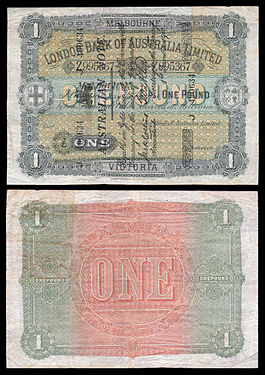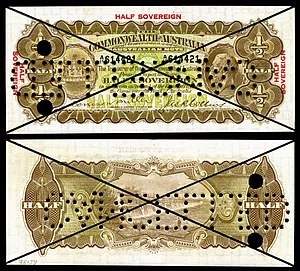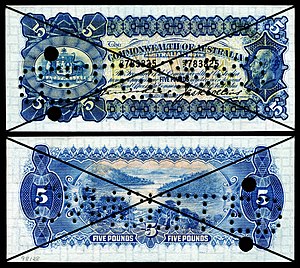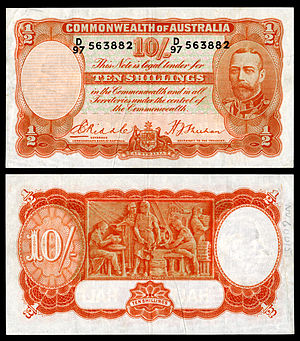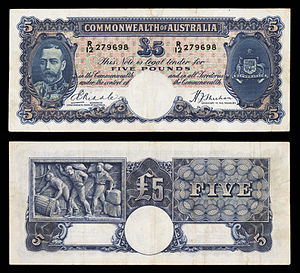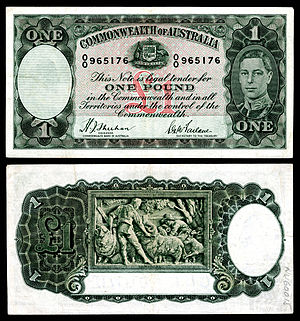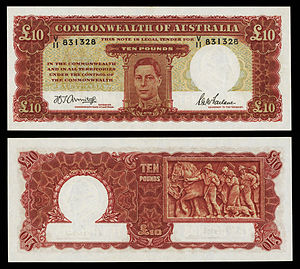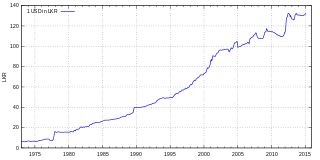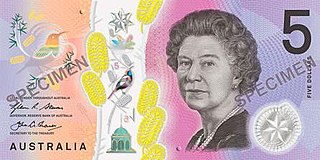| Issue | Value
(Dates) | Banknote | Varieties | Images
Size |
|---|
1913 First Issue | 0000.25-1916 5 Shillings
c. 1916 | | Cerutty and Collins
(printed, not issued) | O:George V |
|---|
0000.50-1913 10 Shillings
1913 | | Collins and Allen (1913) | O:Arms
R:Goulburn Weir
194 mm × 83 mm (7.6 in × 3.3 in) |
|---|
0001.00-1913 1 Pound
1913 |  | Collins and Allen | O:Crowned arms, blue with multicolour underprint
R:Gold miners underground
184 mm × 92 mm (7.2 in × 3.6 in) |
|---|
0001.00-1913a 1 Pound
(1894)
1914–15 | | Collins and Allen
Emergency issue superscribed note. | O:Allegory of woman with anchor
182 mm × 118 mm (7.2 in × 4.6 in) |
|---|
0001.00-1913 1 Pound
1914–15 | | Collins and Allen
Emergency issue note | O:Black text on multicolour underprint
R:Contemporary inscription
184 mm × 102 mm (7.2 in × 4.0 in) |
|---|
1000.00-19141,000 Pounds
1914–24 | | Collins and Allen
Kell and Collins (1925) | O:Arms
R:Merino sheep in Bungaree
215 mm × 143 mm (8.5 in × 5.6 in) |
|---|
1913 Second Issue | 0000.50-1918 10 Shillings
1915–18 | | Collins and Allen (1915)
Cerutty and Collins (1918) | O:Arms, blue text multicolour underprint, "Half Sovereign" red overprint
R:Goulburn Weir
197 mm × 88 mm (7.8 in × 3.5 in) |
|---|
0001.00-1918 1 Pound
1913–18 | | Collins and Allen (1914)
Cerutty and Collins (1918) | O:Crowned arms, blue with multicolour underprint
R:Gold miners underground
184 mm × 92 mm (7.2 in × 3.6 in) |
|---|
0005.00-1918 5 Pounds
1913–18 | | Collins and Allen
Cerutty and Collins (1918) [nb 2] | O:Arms, blue with multicolour underprint
R:Hawkesbury River landscape
167 mm × 105 mm (6.6 in × 4.1 in) |
|---|
0010.00-1918 10 Pounds
1913–18 | | Collins and Allen
Cerutty and Collins (1918) [nb 2] | O:Arms, blue with multicolour underprint
R:Wagons with bags of grain at Narwonah railway station
165 mm × 102 mm (6.5 in × 4.0 in) [nb 3] |
|---|
0020.00-191820 Pounds
1914–18 | | Collins and Allen
Cerutty and Collins (1918) [nb 2] | O:Arms, blue with multicolour underprint
R:Lumberjacks at Bruny Island
165 mm × 98 mm (6.5 in × 3.9 in) [nb 4] |
|---|
0050.00-191850 Pounds
1914–18 | | Collins and Allen
Cerutty and Collins (1920) [nb 5] | O:Arms, blue with multicolour underprint
R:Merino sheep, Bungaree
166 mm × 102 mm (6.5 in × 4.0 in) [nb 6] |
|---|
0100.00-1918100 Pounds
1914–18 | | Collins and Allen
Cerutty and Collins (1924) [nb 5] | O:Arms, blue with multicolour underprint
R:Leura Falls, Upper Yarra River
168 mm × 102 mm (6.6 in × 4.0 in) [nb 7] |
|---|
1923–25 Issue | 0000.50-1923Half Sovereign
1923 | | Miller and Collins (1923) [nb 8] |
O:George V, brown with multicolour underprint, Half Sovereign overprint
R:Goulburn Weir
180 mm × 78 mm (7.1 in × 3.1 in) |
|---|
0001.00-1923 1 Pound
1923 | | Miller and Collins [nb 8] | O:George V, olive-green with multicolor underprint
R:Cook's landing at Botany Bay
180 mm × 78 mm (7.1 in × 3.1 in) |
|---|
0005.00-1924 5 Pounds
1924–27 | | Kell and Collins (1924) [nb 8]
Kell and Heathershaw (1927) | O:George V, blue with multicolour underprint
R:Hawkesbury River landscape
180 mm × 78 mm (7.1 in × 3.1 in) |
|---|
0010.00-1925 10 Pounds
1925 | | Kell and Collins
(specimen only) [nb 8] | O:George V, red with multicolour underprint
R:Wagons with bags of grain
180 mm × 78 mm (7.1 in × 3.1 in) |
|---|
1926–27 Issue | 0000.50-1926Half Sovereign
1926–33 | | Kell and Collins (1926)
Kell and Heathershaw (1927)
Riddle and Heathershaw (1928)
Riddle and Sheehan (1933) | O:George V, brown with multicolour underprint, Half Sovereign overprint
R:Goulburn Weir
180 mm × 78 mm (7.1 in × 3.1 in) |
|---|
0001.00-1926 1 Pound
1926–32 | | Kell and Collins (1926)
Kell and Heathershaw (1927)
Riddle and Heathershaw (1927)
Riddle and Sheehan (1932) | O:George V, olive-green with multicolor underprint
R:Cook's landing at Botany Bay
180 mm × 78 mm (7.1 in × 3.1 in) |
|---|
0005.00-1927 5 Pounds
1927–32 | | Riddle and Heathershaw (1927)
Riddle and Sheehan (1932) | O:George V, blue with multicolour underprint
R:Hawkesbury River landscape
180 mm × 78 mm (7.1 in × 3.1 in) |
|---|
0010.00-1925 10 Pounds
1925–33 |  | Kell and Collins (1925)
Riddle and Heathershaw (1925)
Riddle and Sheehan (1933) | O:George V, red with multicolour underprint
R:wagons with bags of grain at Narwonah railway station
180 mm × 77 mm (7.1 in × 3.0 in) |
|---|
1933–34 Issue | 0000.50-1933 10 Shillings
1933 | | Riddle and Sheehan (1933) | O:George V, brown with multicolour underprint
R:manufacturing allegory
WM:Edward VIII as Prince of Wales
155 mm × 81 mm (6.1 in × 3.2 in) [nb 7] |
|---|
0000.50-1934 10 Shillings
1934 | | Riddle and Sheehan (1934) | O:George V, brown with multicolour underprint, overprint Ten Shillings
R:manufacturing allegory
WM:Edward VIII as Prince of Wales
155 mm × 81 mm (6.1 in × 3.2 in) [nb 7] |
|---|
0000.50-1936 10 Shillings
1936–39 | | Riddle and Sheehan (1936) | O:George V, orange with multicolour underprint, overprint Ten Shillings
R:manufacturing allegory
WM:Edward VIII as Prince of Wales, size reduced
137 mm × 76 mm (5.4 in × 3.0 in) [nb 7] |
|---|
0001.00-1933 1 Pound
1933–38 | | Riddle and Sheehan | O:George V, green with multicolour underprint
R:shepherds with sheep
WM:Edward VIII as Prince of Wales
155 mm × 79 mm (6.1 in × 3.1 in) [nb 7] |
|---|
0005.00-1933 5 Pounds
1933–39 | | Riddle and Sheehan | O:George V, blue with multicolour underprint
R:dock workers with barrels and sacks
WM:Edward VIII as Prince of Wales
181 mm × 79 mm (7.1 in × 3.1 in) |
|---|
0010.00-1934 10 Pounds
1934–39 | | Riddle and Sheehan | O:George V, red with multicolour underprint
R:allegory of agriculture
WM:Edward VIII as Prince of Wales
181 mm × 79 mm (7.1 in × 3.1 in) |
|---|
1938–40 Issue | 0000.25-1946 5 Shillings
1946 | | Armitage and McFarlane
(not Issued) | O:George VI, black with red-brown underprint
R:Australian crown coin
|
|---|
0000.50-1939 10 Shillings
1939–54 | | Sheehan and McFarlane (1939)
Armitage and McFarlane (1942)
Coombs and Watt (1949)
Coombs and Wilson (1952) | O:George VI, orange with multicolour underprint
R:allegory of manufacturers
WM:Captain James Cook
137 mm × 76 mm (5.4 in × 3.0 in) [nb 7] |
|---|
0001.00-1938 1 Pound
1938–52 | | Sheehan and McFarlane (1938)
Armitage and McFarlane (1942)
Coombs and Watt (1949)
Coombs and Wilson (1952) | O:George VI, green with multicolour underprint
R:shepherds with sheep
WM:Captain James Cook
155 mm × 79 mm (6.1 in × 3.1 in) [nb 7] |
|---|
0005.00-1939 5 Pounds
1939–52 | | Sheehan and McFarlane (1939)
Armitage and McFarlane (1941)
Coombs and Watt (1949)
Coombs and Wilson (1952) | O:George VI, blue with multicolour underprint
R:dock workers with barrels and sacks
WM:Captain James Cook
181 mm × 79 mm (7.1 in × 3.1 in) |
|---|
0010.00-1940 10 Pounds
1940–52 | | Sheehan and McFarlane (1940)
Armitage and McFarlane(1943)
Coombs and Watt (1949)
Coombs and Wilson (1952) | O:George VI, red with multicolour underprint
R:allegory of agriculture
WM:Captain James Cook
181 mm × 79 mm (7.1 in × 3.1 in) |
|---|
0050.00-193950 Pounds
1939 | | Sheehan and McFarlane
specimen only, not issued | O:George VI, purple with multicolour underprint
WM:Captain James Cook
|
|---|
0100.00-1939100 Pounds
1939 | | Sheehan and McFarlane
specimen only, not issued | O:George VI, brown with multicolour underprint
WM:Captain James Cook (suspected)
|
|---|
1953–54 Issue | 0000.50-1954 10 Shillings
1954–66 | | Coombs and Wilson (1954)
Coombs and Wilson (1961) | O:Matthew Flinders, arms, brown with multicolour underprint
R:Old Parliament House
WM:Captain James Cook
137 mm × 76 mm (5.4 in × 3.0 in) |
|---|
0001.00-1954 1 Pound
1954–60 | | Coombs and Wilson | O:Elizabeth II, arms, green with multicolour underprint
R:Charles Sturt and Hamilton Hume
WM:Captain James Cook
156 mm × 81 mm (6.1 in × 3.2 in) |
|---|
0005.00-1954 5 Pounds
1954–59 | | Coombs and Wilson | O:Sir John Franklin, arms, blue on multicolour underprint
R:bull and cow's head, sheep
WM:Captain James Cook
167 mm × 79 mm (6.6 in × 3.1 in) |
|---|
0010.00-1954 10 Pounds
1954–59 | | Coombs and Wilson | O:Gov. Arthur Phillip, arms, red and black with multicolour underprint
R:allegory of woman with compass, science and industry
181 mm × 79 mm (7.1 in × 3.1 in) |
|---|
1960–61 Issue | 0005.00-1960 5 Pounds
1960–65 | | Coombs and Wilson | O: Sir John Franklin, arms, black on blue underprint
R:bull and cow's head, sheep
WM:Captain James Cook
167 mm × 79 mm (6.6 in × 3.1 in) |
|---|
0010.00-1960 10 Pounds
1960–65 | | Coombs and Wilson | O:Gov. Arthur Phillip, arms, black with red underprint
R:allegory of woman with compass, science and industry
WM:Captain James Cook
181 mm × 79 mm (7.1 in × 3.1 in) |
|---|

